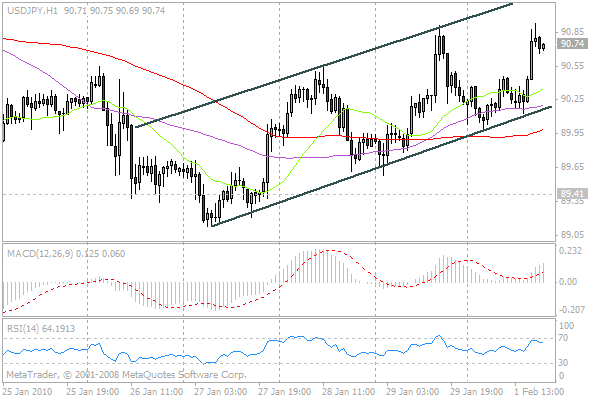By GCI Forex Research
Fundamental Outlook at 1500 GMT (EDT + 0500)
€
The euro appreciated vis-à-vis the U.S. dollar today as the single currency tested offers around the US$ 1.3935 level and was supported around the $1.3850 level. The common currency followed U.S. equities markets higher as increased risk demand jumped on speculation the global economic recovery will continue. Dealers also lifted the common currency as it was reported that EMU-16 PMI improved to 52.4 in January from 51.6 in December, following Germany’s lead with its PMI improvement to 53.7. A draft copy of the upcoming Group of Seven communiqué reports “Market volatility, in particular in the foreign exchange market, could destabilize the nascent global recovery by placing growth on an unbalanced path and trigger unwelcome protectionist reactions.” G7 finance ministers will convene in northern Canada in early February and two hot topics are expected to be exit strategies from the provision of global stimulus and China’s currency. ECB President Trichet this weekend said policymakers “will do whatever is necessary to give all our citizens…price stability.” Trichet also noted U.S. policymakers have reassured him that they favour a strong U.S. dollar. In U.S. news, President Obama released details of his latest US$ 3.8 trillion budget today and it calls for a broad US$ 1.9 trillion tax increase by returning to pre-2001 ordinary income tax rates for higher earners. A US$ 1.5 trillion deficit is expected to materialize by the end of the next fiscal year and the budget also includes a US$ 100 billion job stimulus package that has not yet been passed by Congress. The Federal Reserve today reported that fewer banks tightened lending standards in Q4 2009 as the economy continued to recover. Data released in the U.S. today saw December personal income print at +0.4%, down from the revised +0.5% November reading, while personal spending fell to +0.2% from a revised +0.7%. Also, the December PCE deflator came in at +2.1% y/y while the core PCE reading was up 0.1% m/m. Additionally, the January headline ISM manufacturing index improved to 58.4 from the prior reading of 55.9, the sixth consecutive monthly increase, while the ISM prices paid sub-index rallied to 70.0 from the previous reading of 61.5. Moreover, December construction spending was off 1.2% m/m. Traders await the release of December pending home sales data tomorrow. Euro bids are cited around the US$ 1.3740 level.
¥/ CNY
The yen depreciated vis-à-vis the U.S. dollar today as the greenback tested offers around the ¥90.95 level and was supported around the ¥89.85 level. Bank of Japan Chief Economist Momma reported “the risk that the Japanese economy will fall off from a cliff is small, but there is still a long way to go. Even if the global economy continues to recover, the spread of that to capital spending and the labour market will be limited.” Momma also indicated capital spending will not indicate signs of a rebound until the fiscal year beginning in April 2011 and said the labour market will also remain weak. Core consumer prices data that were recently released confirmed a 1.2% decline in December, the latest evidence of entrenched deflationary pressures. Momma predicted the pace of the decline in CPI will be around 1% for some time. Many BoJ-watchers believe the central bank will introduce new emergency liquidity provision programs in Q1 or early Q2, possibly including an increase in its purchase of Japanese government bonds. The markets continue to speculate that the downward trajectory of Japanese interest rates will continue with March 2010 Euroyen futures contracts indicating a rate of 0.420%, compared with 0.360% for September 2010. The Nikkei 225 stock index climbed 0.07% to close at ¥10,205.02. U.S. dollar offers are cited around the ¥94.75 level. The euro moved higher vis-à-vis the yen as the single currency tested offers around the ¥126.50 level and was supported around the ¥124.65 level. The British pound moved higher vis-à-vis the yen as sterling tested offers around the ¥144.80 level while the Swiss franc moved higher vis-à-vis the yen and tested offers around the ¥85.90 level. In Chinese news, the U.S. dollar appreciated vis-à-vis the Chinese yuan as the greenback closed at CNY 6.8275 in the over-the-counter market, up from CNY 6.8269. People’s Bank of China adviser Fan Gang reported China’s “real worry” remains asset bubbles that could emerge as China’s economy emerges from a crisis period into a “boom time.” Fan also noted moves by PBoC to reduce liquidity last month were “timely and necessary.” There is speculation that PBoC may hike rates when consumer price inflation rises above 2.5%. Data released in China today saw January PMI recede to 55.8 from 56.6 in December.
₤
The British pound moved lower vis-à-vis the U.S. dollar today as cable tested bids around the US$ 1.5850 level and was capped around the $1.5975 level. Many data were released in the U.K. today. First, January manufacturing PMI improved to 56.7 from 54.6, a fifteen-year high. Second, December mortgage approvals decreased to 59,020. Third, net lending to individuals rose by ₤1.2 billion in December. Fourth, Hometrack January house prices were up +0.1%. Bank of England is expected to keep interest rate policy unchanged this week. There is some speculation, however, that Bank of England may pause its ₤200 billion bond purchase plan but maintain the option to extend it further. Cable bids are cited around the US$ 1.5720 level. The euro moved higher vis-à-vis the British pound as the single currency tested offers around the ₤0.8765 level and was supported around the ₤0.8680 level.
CHF
The Swiss franc appreciated vis-à-vis the U.S. dollar today as the greenback tested bids around the CHF 1.0565 level and was capped around the CHF 1.0625 level. The media reported Swiss National Bank is unlikely to abandon its policy to keep a lid on the Swiss franc even though the domestic economy continues to improve. Data released in Switzerland today saw January PMI improve to 56.0 from 53.7 in December. Data released in Switzerland last week saw the December UBS consumption indicator fall to 1.2 from 1.26 in November. Swiss National Bank President Hildebrand recently reported he is “extremely interested” in the Obama administration’s bank proposals. The euro moved higher vis-à-vis the Swiss franc as the single currency tested offers around the CHF 1.4735 level while the British pound moved lower vis-à-vis the Swiss franc and tested bids around the CHF 1.6785 level.
Forex Daily Market Commentary provided by GCI Financial Ltd.
GCI Financial Ltd (”GCI”) is a regulated securities and commodities trading firm, specializing in online Foreign Exchange (”Forex”) brokerage. GCI executes billions of dollars per month in foreign exchange transactions alone. In addition to Forex, GCI is a primary market maker in Contracts for Difference (”CFDs”) on shares, indices and futures, and offers one of the fastest growing online CFD trading services. GCI has over 10,000 clients worldwide, including individual traders, institutions, and money managers. GCI provides an advanced, secure, and comprehensive online trading system. Client funds are insured and held in a separate customer account. In addition, GCI Financial Ltd maintains Net Capital in excess of minimum regulatory requirements.
DISCLAIMER: GCI’s Daily Market Commentary is provided for informational purposes only. The information contained in these reports is gathered from reputable news sources and is not intended to be U.S.ed as investment advice. GCI assumes no responsibility or liability from gains or losses incurred by the information herein contained.









